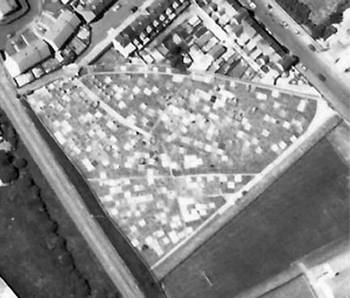|
The History of the Dougher Cemetery
by Jim McIllmurry

Starting with the history of the parish of Shankill. The first priest appointed to our parish was Rev, Father John O’Kelly from Mayobridge who was appointed the first administrator of the faith for the new Parish of Shankill that separated from Seagoe in 1788. He was appointed Chancellor of the diocese in 1802. He first celebrated mass in a small shed in Tannaghmore North and in a house belonging to an Edward Magennis somewhere around Church Place, that would have been 1788 -89.
The Dougher site was presented free of charge to Father O’Brien in 1800 by Charles Brownlow (I have covered this history in the section) “The Dougher Wood Mill”.
Brownlow only gave Father O’Brien the part of the site which housed the disused building.
The Building was converted and repaired and became the Dougher Catholic Chapel.
 In 1822, Reverend William O'Brien, from Aghalee, was ordained and appointed C.C. Shankill, He began the registration of Catholic Baptisms in the Parish. Two years later he was appointed Parish Priest when Rev, Father Kelly died. Rev, Father William O’Brien went back to Charles Brownlow in 1827 and asked for the remainder of the site in the Dougher Valley for a Cemetery, his request was granted. Rev, Father O’Brien later became the Vicar general of the diocese. It was he that approached Charles Brownlow in 1829 and request a site for a larger church in the townland of Derry (now North Street) 1829 was the year of the catholic Emancipation, so his timing was fitting to request a site. Rev, Father O’Brien began work on the new church immediately, it was completed and dedicated on the 1st September 1833. It was Rev, Father William O’Brien who also converted the Dougher church into a school. He died on the 31st May 1870 aged 74. His remains are interred in the church he built, St, Peter’s. In 1822, Reverend William O'Brien, from Aghalee, was ordained and appointed C.C. Shankill, He began the registration of Catholic Baptisms in the Parish. Two years later he was appointed Parish Priest when Rev, Father Kelly died. Rev, Father William O’Brien went back to Charles Brownlow in 1827 and asked for the remainder of the site in the Dougher Valley for a Cemetery, his request was granted. Rev, Father O’Brien later became the Vicar general of the diocese. It was he that approached Charles Brownlow in 1829 and request a site for a larger church in the townland of Derry (now North Street) 1829 was the year of the catholic Emancipation, so his timing was fitting to request a site. Rev, Father O’Brien began work on the new church immediately, it was completed and dedicated on the 1st September 1833. It was Rev, Father William O’Brien who also converted the Dougher church into a school. He died on the 31st May 1870 aged 74. His remains are interred in the church he built, St, Peter’s.
The wealthier catholic residents of Lurgan erected imposing headstones, the poor, and there were many, erected simple wooden crosses, these perished in time, hence most of the earliest inhabitants of Lurgan lie in unmarked graves.The Dougher closed to burials a few decades ago, but occasionally family plots are opened at request.
Some may recall funerals from St,Peter’s church crossing the railway lines at Kilmaine Street on route to the Dougher by means of a railway crossing and gates beside the foot bridge.
An unknown number of people are buried in area which is now the railway bank, (The railway came to Lurgan in 1841 so the area was raised to accommodate the track).
The practice of burying children who died before they were baptised, those who took their own lives, and those living on the roads including many deemed insane, who were suffering from mental illness. These graves were never marked as the Catholic Church of that time did not permit them to be interred with ecclesiastical rites in consecrated ground. A policy they changed many years ago.
At a guess, hundreds are buried in the area which is now the railway banking.
I have recently acquired funds and asked Gerard Towe to erect a permanent granite memorial to those buried in the un consecrated region of the cemetery and it should be erected later this year.
Our thanks to Jim for his kindness in giving us permission to publish these stories here.


| 
